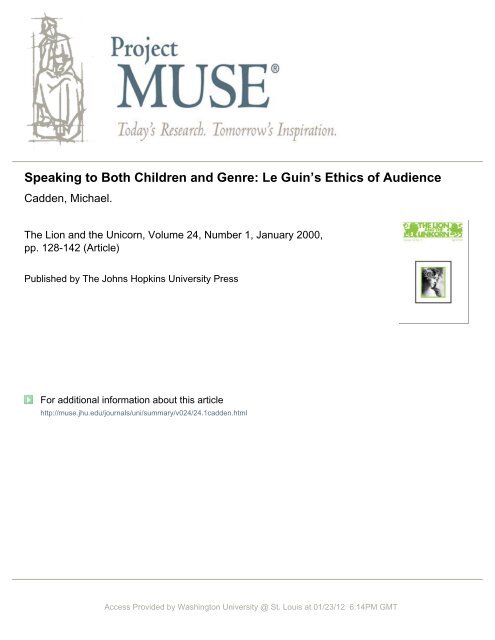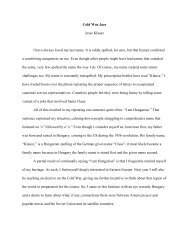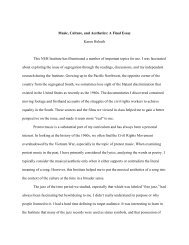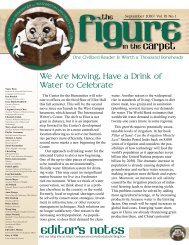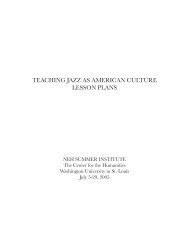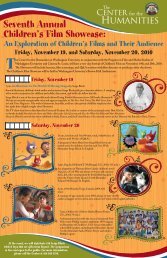You also want an ePaper? Increase the reach of your titles
YUMPU automatically turns print PDFs into web optimized ePapers that Google loves.
Speaking to Both Children <strong>and</strong> Genre: Le Guin’s Ethics of AudienceCadden, Michael.<strong>The</strong> <strong>Lion</strong> <strong>and</strong> <strong>the</strong> <strong>Unicorn</strong>, Volume <strong>24</strong>, Number 1, January 2000,pp. 128-142 (Article)Published by <strong>The</strong> Johns Hopkins University PressFor additional information about this articlehttp://muse.jhu.edu/journals/uni/summary/v0<strong>24</strong>/<strong>24</strong>.1cadden.htmlAccess Provided by Washington University @ St. Louis at 01/23/12 6:14PM GMT
128Mike CaddenSpeaking to Both Children <strong>and</strong> Genre:Le Guin’s Ethics of AudienceMike Cadden<strong>The</strong>re are precisely as many genres as we need, genres whose conceptualshape is precisely determined by that need.(Adena Rosmarin)Writers who claim that <strong>the</strong>y write only for <strong>the</strong>mselves deny that <strong>the</strong>influence of ei<strong>the</strong>r genre or a readership guides <strong>the</strong> writing. <strong>The</strong>se writersargue by implication that <strong>the</strong>y nei<strong>the</strong>r communicate with readers norobserve generic traditions; <strong>the</strong>y simply write to <strong>the</strong>mselves. <strong>The</strong>y are selfproclaimedliterary isolationists. Jill Paton Walsh (“<strong>The</strong> Writers in <strong>the</strong>Writer” 4), Ka<strong>the</strong>rine Paterson (47, 50), P. L. Travers (63), Mollie Hunter(12), <strong>and</strong> Michael Steig (Bottner 4) all directly point to <strong>the</strong>mselves as atleast partial audience in <strong>the</strong>ir commentaries on writing for children, but<strong>the</strong>y don’t go so far as to claim that <strong>the</strong>y don’t write for children. ArthurRansome made “<strong>the</strong> reiterated denial that he wrote for children” (Wall30), but he ultimately “made a distinction between writing for children<strong>and</strong> writing to children” (30), claiming <strong>the</strong> latter occupation for himself.Peter Hollindale believes that Ransome is less interested in child readersthan he is childhood (“Signs” 31), which Hollindale considers a feature of<strong>the</strong> genre of children’s literature. In any case, writers for children whowould deny both interest in <strong>and</strong> consciousness of form <strong>and</strong> audienceargue that <strong>the</strong>irs is children’s literature entirely by accident. However, abook becomes a children’s book—intended by <strong>the</strong> writer or not—whencritics identify generic features (text) <strong>and</strong>/or children find that <strong>the</strong> bookspeaks to <strong>the</strong>m (context).I’m more interested in <strong>the</strong> children’s writer who claims both to writechildren’s books <strong>and</strong> to write books for children—those writers whoconflate text <strong>and</strong> context. When <strong>the</strong> children’s author describes “writing<strong>The</strong> <strong>Lion</strong> <strong>and</strong> <strong>The</strong> <strong>Unicorn</strong> <strong>24</strong> (2000) 128–142 © 2000 by <strong>The</strong> Johns Hopkins University Press
Speaking to Both Children <strong>and</strong> Genre 129to children,” we are invited to see a rhetorical relationship between awriter <strong>and</strong> a reader; when <strong>the</strong> children’s writer discusses “writingchildren’s literature,” we are invited to consider <strong>the</strong> text as a member of aparticular genre or text type. We shouldn’t be surprised when authorssound like rhetors at one moment, <strong>and</strong> <strong>the</strong> next moment—perhaps in <strong>the</strong>next sentence—<strong>the</strong>y go on to talk about <strong>and</strong> even define <strong>the</strong>ir work intextual terms only. This authorial tendency to combine textual <strong>and</strong>contextual definitions of children’s literature frustrates critics eager todistinguish clearly between “book people” <strong>and</strong> “child people.” Afterdiscussing <strong>the</strong> blurring of <strong>the</strong>se boundaries in general, I will show inparticular how Ursula Le Guin, famous for blurring both <strong>the</strong> edges <strong>and</strong>ages of genre, creates a dialogue between <strong>the</strong> textual <strong>and</strong> <strong>the</strong> contextual asshe attempts over time to define what she does. Ultimately I hope to showhow Le Guin distinguishes between her audiences based on <strong>the</strong> ethics ofboth audience <strong>and</strong> genre.Those authors who have primarily (though not solely) a rhetorical viewof what <strong>the</strong>y do see <strong>the</strong> text as a conduit for <strong>the</strong> delivery of <strong>the</strong>ir ownmessage to real children. 1 Beyond mere lecture, Betsy Byars, MollieHunter, Ka<strong>the</strong>rine Paterson, <strong>and</strong> C. S. Lewis all claim to engage in adialogue with actual children. 2 Byars’s sense of audience comes, sheclaims, directly from her own children, who also give her <strong>the</strong> ideas for herbooks (7). Hunter, too, credits dialogue with her children for her success(8–9). Paterson makes her process <strong>and</strong> aim clear: “I write for my own fourchildren <strong>and</strong> for o<strong>the</strong>rs who are faced with <strong>the</strong> question of whe<strong>the</strong>r <strong>the</strong>ydare to become adult” (109). C. S. Lewis is perhaps <strong>the</strong> most well-knowncritic of <strong>the</strong> cult of <strong>the</strong> generalized child: <strong>The</strong>re needs to be, he says, adialogue between an author <strong>and</strong> a child, a real person with whom oneei<strong>the</strong>r actually consults or about which <strong>the</strong> author can predict responsesbased on <strong>the</strong> history of acquaintance. Lewis points out that <strong>the</strong> “participantsmodify each o<strong>the</strong>r” <strong>and</strong> form “a community” (1075).But <strong>the</strong>se authors for children don’t always make clear distinctionsbetween audience <strong>and</strong> genre. Authors as influential as those cited aboveseem to shift <strong>the</strong>ir gaze from genre to reader. For example, Lewis claimshe writes in <strong>the</strong> particular genre of “children’s literature” in <strong>the</strong> caseswhen children’s literature “is <strong>the</strong> best art form for what [he has] to say”(1075). Here Lewis shows that he is as much engaged in a dialogue withgenre as with some individual person, careful never to say which it is tha<strong>the</strong> does (to whom he speaks?) in all cases. <strong>The</strong>re is no small bit of ironyin <strong>the</strong> fact that Lewis’s “art form” is as general as <strong>the</strong> generalized conceptof <strong>the</strong> child audience that he cautions writers to avoid. Ka<strong>the</strong>rine Paterson
130Mike Caddenalso makes a shift from audience to genre in one breath, blurring <strong>the</strong>distinction between <strong>the</strong>m. As if in response to Zohar Shavit’s claim that“writing for children usually means that <strong>the</strong> writer is limited in his optionsof text manipulation” (66), Paterson writes, “‘Don’t you feel constrictedwriting for children?’ <strong>the</strong>y’ll ask. William, don’t you find fourteen tightlyrhymed lines an absolute prison? Ah, Pablo, if you could just yank thatpicture off that lousy scrap of canvas! You get <strong>the</strong> point” (33). WhatPaterson <strong>and</strong> Lewis illustrate is that it is both easy <strong>and</strong> sensible to combine<strong>the</strong> notions of genre <strong>and</strong> audience when one is writing in a genre namedfor an audience—text <strong>and</strong> context become conflated. Genre <strong>and</strong> audienceare combined ra<strong>the</strong>r than confused with each o<strong>the</strong>r. <strong>The</strong>se authors haven’tmade an error; <strong>the</strong>y have made an erasure: <strong>The</strong>y erase <strong>the</strong> distinctionbetween audience <strong>and</strong> genre in children’s literature.Perhaps it isn’t odd to talk about genre as an audience. Genre is anaudience in its own way, an audience to which people write, a livingtradition with clear rules <strong>and</strong> expectations for discursive behavior. <strong>The</strong>dual audience in this case is composed of both children <strong>and</strong> traditionra<strong>the</strong>r than that of children <strong>and</strong> adults.<strong>The</strong> critic’s impulse, however, is to make a distinction betweencategories—between texts <strong>and</strong> contexts. Peter Hunt suggests that “<strong>the</strong>critic of children’s literature has only two choices”: She can ei<strong>the</strong>rdecontextualize <strong>the</strong> text by ignoring <strong>the</strong> audience, or she can grant <strong>the</strong>primacy of <strong>the</strong> audience as <strong>the</strong> foundation of <strong>the</strong> genre <strong>and</strong> communicateto that audience, however perceived (“Necessary Misreadings” 108).Hunt’s position is that <strong>the</strong>re is an absolute <strong>and</strong> necessary choice. Lewis’s<strong>and</strong> Paterson’s conflation show that such easy distinctions may be toocomplicated to count on, if not actually impossible.Respected critics can be as ambivalent about <strong>the</strong> differences betweentexts <strong>and</strong> contexts as successful authors. Peter Hollindale considers “<strong>the</strong>author’s textual negotiations with <strong>the</strong> child” (“Signs” 12) to be whatmakes children’s literature “unique, <strong>and</strong> different in kind from o<strong>the</strong>r formsof literature” (12), yet questions that negotiation when he says that “<strong>the</strong>adult children’s author is always obsolete” (22) <strong>and</strong> that “children” is“an increasingly unstable concept” (25). Jacqueline Rose maintains that“<strong>the</strong>re is no child behind <strong>the</strong> category ‘children’s fiction,’ o<strong>the</strong>r than <strong>the</strong>one which <strong>the</strong> category itself sets in place” (10), yet she is concernedabout <strong>the</strong> potential for unethical authorial control over real child readersthat might result in a sort of “molestation” (70). Barbara Wall notes that<strong>the</strong>re is a “substantial barrier of age” between adult writer <strong>and</strong> child readerthat “may be surmounted or traversed” but never removed (20). Does“traversing” <strong>the</strong> barrier mean that writers will “serve . . . <strong>the</strong>ir chosen
Speaking to Both Children <strong>and</strong> Genre 131audience” (20)? Can an implied audience be served? For Wall insists that“<strong>the</strong> real author knows only <strong>the</strong> implied reader, a presence his or her textinescapably calls into being” (7). Wall, <strong>the</strong>n, suggests that it is possible totraverse a barrier that is impossible to traverse. <strong>The</strong> implied audience thatcan be served is <strong>the</strong> genre itself.Children’s writers who claim an audience may more easily weaveissues of textuality into <strong>the</strong>ir discourse by talking about ethical fiction;ethical fiction is discussed in <strong>the</strong>matic <strong>and</strong> structural terms, borne of aconcern for an audience. Claudia Mills, prolific both as a children’s writer<strong>and</strong> a critic of children’s literature, argues that critics of children’sliterature “are more willing than many o<strong>the</strong>r critics to concede that oneaim of a children’s book is to shape <strong>the</strong> evolving character of its readers”(181), even <strong>the</strong> “book people,” presumably. Even a critic like JacquelineRose, someone who denies <strong>the</strong> existence of <strong>the</strong> audience category“children,” claims that “writers for children must know <strong>and</strong> underst<strong>and</strong>children” (70). Ka<strong>the</strong>rine Paterson makes this vow: “I cannot, will not,withhold from my young readers <strong>the</strong> harsh realities of human hunger <strong>and</strong>suffering <strong>and</strong> loss, but nei<strong>the</strong>r will I neglect to plant that stubborn seed ofhope” (38). <strong>The</strong> distressing is not omitted; it is merely treated in a waythat Paterson believes will work for a child audience, an audience of herown children. “Hopeful realism” <strong>the</strong>n, becomes a special feature ofPaterson’s vision of <strong>the</strong> genre of children’s literature. While Patersonrefuses to water down issues, she also insists that <strong>the</strong>re be a sense of hopeby <strong>the</strong> end of <strong>the</strong> story. Her concern for audience forms <strong>the</strong> textualpossibilities of her version of <strong>the</strong> genre—as simultaneously limiting <strong>and</strong>as limitless as <strong>the</strong> sonnet she compares it to above.Writers who claim an audience of generic tradition ra<strong>the</strong>r than ofchildren might end up with a product similar in structure <strong>and</strong> ethicalquality to <strong>the</strong> writer who conflates audience <strong>and</strong> genre, but that is because<strong>the</strong>y observe <strong>the</strong> needs of <strong>the</strong> genre or of <strong>the</strong> implied audience Wall herselfimplies. Ethical writers have continuously influenced <strong>the</strong> textual traditionof children’s fiction because of <strong>the</strong>ir concerns for children; subsequentefforts by writers less rhetorically or ethically conscious are affectedbecause of <strong>the</strong>ir concerns for satisfying tradition. As if in response toPaterson, Jill Paton Walsh asks, “how can I feel any responsibility to myaudience when I don’t know who my audience are?” (“<strong>The</strong> Writer’sResponsibility” 30). Wayne Booth argues that “most who have rejectedethical criticism . . . [claim] that authors must not be burdened withworries about <strong>the</strong> reader’s ultimate welfare if <strong>the</strong>y are to serve <strong>the</strong>ir artproperly” (127). Since Walsh doesn’t “know” <strong>the</strong> actual readers <strong>and</strong> since<strong>the</strong> readers, whoever <strong>the</strong>y are, don’t have a responsibility to <strong>the</strong> writer,
132Mike CaddenWalsh is “responsible to nobody” (“<strong>The</strong> Writer’s Responsibility” 32) exceptto <strong>the</strong> book itself as artistic product (35). But <strong>the</strong> creation of ethicalart isn’t limited to those with specific notions of a child audience or tothose who have generalized notions of children. 3 It is entirely possible thatwhat one writer considers a matter of audience, ano<strong>the</strong>r writer withoutrhetorical concerns might find to be a textual feature of children’s books.If Walsh doesn’t consider children as she writes her children’s books, she<strong>the</strong>n writes with an eye focused on generic tradition. For her to write whatshe considers “children’s literature” while ignoring a sense of audiencenecessarily means that her guideline—her context—is genre, however sheperceives it.Both writers are known for <strong>the</strong>ir hopeful yet unflinching social realism.Paterson’s self-consciousness about an audience is <strong>the</strong> reason she writeshopeful literature; Walsh writes hopeful realism for her own reasons apartfrom audience considerations, though it works as children’s literatureowing to, in part, <strong>the</strong> presence of this feature. Ethical art is art,none<strong>the</strong>less. Wayne Booth argues that “<strong>the</strong> distinction between genuineliterature (or ‘poetry’) <strong>and</strong> ‘rhetoric’ or ‘didactic’ literature is entirelymisleading if it suggests that some stories . . . are purged of all teaching”(151–52). <strong>The</strong> idea that all good art is ethical enables writers for childrento serve both text <strong>and</strong> context . . . or <strong>the</strong> two traditionally dem<strong>and</strong>ingaudiences of children <strong>and</strong> children’s literature. We see <strong>the</strong> same conflationof audience <strong>and</strong> art, text <strong>and</strong> context, ethics <strong>and</strong> genre in Le Guin’s selfcriticaldiscourse.<strong>The</strong> idea of <strong>the</strong> crossover writer—<strong>the</strong> writer who writes for bothchildren <strong>and</strong> adults—has been on children’s literature critics’ minds lately.Not much had been said about crossover writers before <strong>the</strong> special issue of<strong>The</strong> <strong>Lion</strong> <strong>and</strong> <strong>the</strong> <strong>Unicorn</strong> in 1978. David Galef has reintroduced <strong>the</strong>matter with his argument that “an equally complex but perhaps morefruitful query than [‘What is a children’s book?’] is ‘What enables anauthor to write both children’s books <strong>and</strong> adult fiction?’” (29). Critics areseeing <strong>the</strong> worth of examining <strong>the</strong> nature of children’s literature at <strong>the</strong> siteof <strong>the</strong> successful crossover writer because such writers actually perform<strong>the</strong> genre distinctions in question. Mitzi Myers’s question about <strong>the</strong>crossover writer seems a natural one to ask of Le Guin: “[W]hatcontinuities or divergences mark <strong>the</strong> writings of those who create separateworks for child <strong>and</strong> adult?” (120).Le Guin, like Paterson <strong>and</strong> Hunter, is concerned with <strong>the</strong> real live childaudience who reads her books. She describes her duty to her muchyounger audience by defining what she won’t do in <strong>the</strong> particular genre ofchildren’s literature:
Speaking to Both Children <strong>and</strong> Genre 133<strong>the</strong>re’s a certain type of hopelessness that I just can’t dump on kids. Ongrown-ups sometimes; but as a person with kids, who likes kids, whoremembers what being a kid is like, I find <strong>the</strong>re are things I can’t inflict on<strong>the</strong>m. <strong>The</strong>re’s a moral boundary, in this sense, that I’m aware of in writinga book for young adults. (McCaffery <strong>and</strong> Gregory 82)Like Hunter <strong>and</strong> Paterson, Le Guin refuses to absolve herself of anyresponsibility. She shows here a rhetorical awareness regarding herwriting to children. Le Guin has written recently that “a denial of authorialresponsibility, a willed unconsciousness, is elitist, <strong>and</strong> it does impoverishmuch of our fiction in every genre, including realism” (A Fisherman of <strong>the</strong>Inl<strong>and</strong> Sea 4–5). This statement, written to introduce a collection of shortstories for <strong>the</strong> adult market, seems to reinforce her comment above thatethical art is not at all a matter restricted to <strong>the</strong> child audience. Le Guintells us that children “need to be—<strong>and</strong> usually want very much to be—taught right from wrong” (“<strong>The</strong> Child <strong>and</strong> <strong>the</strong> Shadow” 65). Once a childknows <strong>the</strong> difference, a child “[knows] what bad is. Grownups getconfused” (“Introduction, City of Illusions” 141). We all need moral art,Le Guin seems to be saying, though perhaps in different degrees based onage, <strong>and</strong> she marks <strong>the</strong> distinction between being preachy <strong>and</strong> beingethical. In <strong>the</strong> introduction to <strong>The</strong> Word for World is Forest, Le Guin notesthat those writers who yield to <strong>the</strong> temptation of didacticism “forget aboutliberty . . . <strong>and</strong> instead of legislating in divine arrogance, like God orShelley, <strong>the</strong>y begin to preach.” So, while Le Guin has a special concern forchildren, she is ambivalent about <strong>the</strong> real distinction between ethicalfiction for adults <strong>and</strong> for children:[W]riters for children write with as much concern about audience as writersfor adults—indeed, usually with a more conscious <strong>and</strong> perhaps moreethically alert concern. <strong>The</strong>y have to; writing can damage people. Writersfor kids don’t want to damage kids. (Letter to <strong>the</strong> author)<strong>The</strong> adult audience <strong>and</strong> <strong>the</strong> child audience, despite <strong>the</strong>ir differing degreesof confusion about right <strong>and</strong> wrong <strong>and</strong> <strong>the</strong>ir needs for ethical art, may notbe so very different that <strong>the</strong>y provide Le Guin with a useful guide formarking generic difference—a difference she must see for her to commenton her “children’s books” at all.Le Guin seems forceful when she denies audience awareness altoge<strong>the</strong>r,not unlike Walsh <strong>and</strong> despite her own protestation about servingactual children. Le Guin claims that she doesn’t “know of anything you‘do’ for kids that is different than you do for adults” (McCaffery <strong>and</strong>Gregory 82). Despite her observation that she has a stronger sense of herfiercely loyal readership now than she did years ago, Le Guin stillmaintains that to think of <strong>the</strong> reader “is fatal” (Walsh 203). “Ultimately
Speaking to Both Children <strong>and</strong> Genre 135little necessarily to do with children; it is not <strong>the</strong> title of a readership butof a genre, collateral perhaps, with fable <strong>and</strong> fantasy” (“Ideology” 9).Le Guin implies <strong>the</strong> equation of fantasy <strong>and</strong> children’s literature:And I also rejoice in <strong>the</strong> privilege of sharing this honor, if I may, with myfellow writers, not only in <strong>the</strong> field of children’s books, but in that even lessrespectable field, science fiction. For I am not only a fantasist but a sciencefiction writer, <strong>and</strong> odd though it may seem, I am proud of both. (“NationalBook Award Acceptance Speech” 52)She also makes <strong>the</strong> link between fantasy <strong>and</strong> children’s fiction when sheasserts that “fantasists are childish, childlike. <strong>The</strong>y play games” (“Do-It-Yourself Cosmology” 122), though fantasy is a game “played for veryhigh stakes” (“From Elfl<strong>and</strong> to Poughkeepsie” 79) because of its focus onmoral matters. Le Guin’s use of <strong>the</strong> words adult <strong>and</strong> children’s seem toserve as synonyms for “our world” (present or future) <strong>and</strong> “alternativeworld” (fantasy), respectively. <strong>The</strong> genre of children’s literature is <strong>the</strong>same as <strong>the</strong> generic tradition that, according to Le Guin, is implicitlymoral when it is well-written—Good when it is good. And it is good toavoid didacticism, which one can do if one gives up <strong>the</strong> control of whatgets written to <strong>the</strong> work itself, which Le Guin claims is essential (Steering<strong>the</strong> Craft 149); if control is given over to <strong>the</strong> “winged words” put into <strong>the</strong>writer’s mouth by generic tradition, Le Guin can write good/Good fantasy,write moral tales for children, <strong>and</strong> not end up preaching to children. From<strong>the</strong> time of <strong>the</strong> essays reproduced in <strong>The</strong> Language of <strong>the</strong> Night on fantasy<strong>and</strong> science fiction (1972–1988) until her letter to me late in November of1995, Le Guin has remained consistent about her views on fantasy <strong>and</strong>children’s literature <strong>and</strong> <strong>the</strong> special role of morality in those genres. <strong>The</strong>consistency becomes, in effect if not in intent, a conflation of fantasy <strong>and</strong>children’s literature, which is a conflation of text <strong>and</strong> context not unlikethat practiced by Lewis, who wrote fantasy for children <strong>and</strong> sciencefiction for adults, or by Paterson, who writes realism for children almostexclusively <strong>and</strong> for whom children’s realistic fiction <strong>and</strong> ethical realismcan be equated without a real need for dividing age-based genres.Le Guin claims that she “finally got [her] pure fantasy vein separatedoff from [her] science fiction vein, by writing A Wizard of Earthsea <strong>and</strong><strong>the</strong>n <strong>The</strong> Left H<strong>and</strong> of Darkness” (“A Citizen of Mondath” 25). Since1973 when she wrote <strong>the</strong> words above, Le Guin has continued to pursuevarious generic paths. Having worked out <strong>the</strong> “different veins,” shecontinued <strong>the</strong> fantasy vein by starting to write specifically for youngchildren through picture books: Leese Webster (1979), Solomon Leviathan’sNine Hundred <strong>and</strong> Thirty-First Trip around <strong>the</strong> World (1983), althoughthis story was first written when Le Guin was a young adult; A Visit from
136Mike CaddenDr. Katz (1988); Fire <strong>and</strong> Stone (1989); <strong>the</strong> Catwings books (1990–1999);<strong>and</strong> A Ride on <strong>the</strong> Red Mare’s Back (1992). All of <strong>the</strong>se texts, all forchildren, have clear <strong>and</strong> necessary elements of fantasy if <strong>the</strong>y aren’tfantasy outright. Interestingly, Very Far Away from Anywhere Else (1976),<strong>The</strong> Beginning Place (1980), <strong>and</strong> Tehanu (1990)—her books usuallyrecognized as those for young adults—clearly represent a range fromrealism to high fantasy with mixing going on in between. Young adultliterature—a literature of transition from age to age—may well markwhere Le Guin allows her age-based genres to blur regarding morality <strong>and</strong>literary genre. In any case, from City of Illusions (1967) to Unlocking <strong>the</strong>Air (1996), Le Guin has kept her adult readers pretty firmly in <strong>the</strong> genresof realism <strong>and</strong> science fiction. Even <strong>the</strong> Orsinian Tales, set in a fictitiousnation, are meant to play in <strong>the</strong> affairs of Eastern Europe, not Roke.Gerard Genette observes that all genres contain several o<strong>the</strong>r genres(65); in Le Guin’s case, ra<strong>the</strong>r, certain genres exist as o<strong>the</strong>r genres, as seenin <strong>the</strong> fantasy/children’s literature relationship. Truth to tell, while LeGuin’s fantasy is also known as her literature for children, it is alsoappropriate for everyone—an inclusive definition of children’s literaturethat is as old as its status as a field of study. “Fantasy is <strong>the</strong> great ageequalizer,”she tells us (“Dreams Must Explain <strong>The</strong>mselves” 49). Is thissimply ano<strong>the</strong>r fly in <strong>the</strong> ointment of demarcation? If so, it should nei<strong>the</strong>rsurprise nor distress us. She pulls in <strong>the</strong> adults as well, after all. But whilefantasy is not incongruous with adult readers (as children’s literature isnot), it is fantasy that enables Le Guin to talk about children, children’sliterature, <strong>and</strong> morality. Ironically, fantasy <strong>and</strong> science fiction might betwo genres that help Le Guin discover a genre o<strong>the</strong>rwise invisible: adultliterature. Famous for both her treatment of <strong>the</strong> “o<strong>the</strong>r” in literature <strong>and</strong>for defying genre, Le Guin may have found herself first confronted with<strong>the</strong> “o<strong>the</strong>r” when she was introduced to age-based genre with <strong>the</strong>publication of A Wizard of Earthsea. Before Ged, what had been simplydifferent genres—realism, short fiction, science fiction, <strong>the</strong> essay—suddenly became subcategories of adult literature(s)—genres that shewrote to when writing to adults. Despite Le Guin’s discourse on morality<strong>and</strong> <strong>the</strong> inclusion of older readers, we continue to recognize Le Guin’schildren’s books by <strong>the</strong> code word fantasy, we recognize her books foradults by <strong>the</strong> code words realism <strong>and</strong> science fiction <strong>and</strong> nonfiction.Maureen Thum’s description of Wilhelm Hauff seems an apt descriptionof Le Guin: Le Guin, like Hauff, explores <strong>the</strong> “area of wonder, of freefloatingpotentialities <strong>and</strong> magical intercessions associated with <strong>the</strong> child’s‘unreal’ world of fantasy, <strong>and</strong> with . . . <strong>the</strong> ‘real’ world of <strong>the</strong> adult” (3).Brian Attebery reminds us that Le Guin’s “first three books of fantasy
Speaking to Both Children <strong>and</strong> Genre 137appeared interspersed with her science fiction novels,” <strong>and</strong> so “it is notsurprising . . . that her fantasies share <strong>the</strong> same concerns as her sciencefiction” (165); David Galef argues that <strong>the</strong>matic parallelism is seen in anumber of “cross-over” writers as well (29). Le Guin’s shared set of<strong>the</strong>mes (freedom, home, journey, identity, o<strong>the</strong>rness as seen in <strong>the</strong> beast<strong>and</strong> alien, <strong>and</strong> <strong>the</strong> courage to construct a self in <strong>the</strong> world) surface in all ofher writing; <strong>the</strong>y are merely articulated in different contexts. PerryNodelman reminds us that “many readers, both children <strong>and</strong> adults, seekout fur<strong>the</strong>r texts by authors <strong>the</strong>y have enjoyed, because <strong>the</strong>y expect acommon thread, a consistency in subject <strong>and</strong> style, in all <strong>the</strong> texts anauthor produces” (145). This is certainly true of Le Guin’s readers.Readers of <strong>The</strong> Dispossessed follow Le Guin to Always Coming Home,perhaps to come home in different ways in different genres; <strong>the</strong> youngreaders of A Ride on <strong>the</strong> Red Mare’s Back will find in Ged’s story <strong>and</strong> <strong>the</strong>nin Shevek’s those same concerns about always coming home, though <strong>the</strong>ytravel from folklore to high fantasy to science fiction to get <strong>the</strong>re.However, given <strong>the</strong> clear generic alliances Le Guin makes betweenfantasy <strong>and</strong> realism (traditional or science fiction) <strong>and</strong> age, her “approachesto <strong>the</strong> <strong>the</strong>mes vary considerably” (Attebery 166).Though genre isn’t a barrier to Le Guin’s <strong>the</strong>mes, genre is an influencefelt from her earliest foray into children’s literature with <strong>the</strong> publication ofA Wizard of Earthsea. Her entry into <strong>the</strong> realm of heroic fantasy with <strong>the</strong>Earthsea series was allowable, she observes, because <strong>the</strong>y were publishedas children’s books. “So long as [she] behaved [herself], obeyed <strong>the</strong> rules,[she] was free to enter <strong>the</strong> heroic realm” (Earthsea Revisioned 7). Le Guinfound that she needed to challenge genre’s influence in order to speak asherself. Until she realized she was <strong>the</strong> mouthpiece of tradition, sheconfused security with freedom; once she realized this, she says, <strong>the</strong> longsuccession of “genre-busting” texts began—texts for adults, that is. As awriter writes within a given genre, “she begins to write against <strong>the</strong> genre,thus changing <strong>and</strong> renewing it. <strong>The</strong> rigid system of genres <strong>and</strong> modes[begins] to disintegrate” (Nikolajeva 7). By bucking tradition, Le Guingives up <strong>the</strong> authority vested in her as a duly appointed officer oftraditional genres <strong>and</strong> creates a new authority for herself. Always ComingHome defies demarcation; Malafrena asks us to consider a fictitiouscountry in a Europe we know. Although she claims that “people arewriting differently <strong>and</strong> <strong>the</strong> genres are all merging” (Walsh, “I Am aWoman Writer” 198), her children’s literature remains fairly genrefaithful.She simultaneously plays with genre in her adult texts whilerespecting <strong>the</strong> integrity of <strong>the</strong> children’s literature/fantasy relationship.So, despite all of her “genre-busting,” Le Guin keeps genre clear in her
138Mike Caddensights (or watches it over her shoulder). Todorov notes that “it is . . .considered a sign of au<strong>the</strong>ntic modernity in a writer if he ceases to respect<strong>the</strong> separation of genres” (13). Rosmarin, too, argues that “to be a modernwriter <strong>and</strong> to write generically is a contradiction in terms” (7). “Weforget,” Scholes reminds us, “that when we attribute total freedom ofchoice to an artist we are constructing a fiction of freedom, projecting ourown needs <strong>and</strong> desires upon a figure who is far less free than we mayassume” (Textual Power 117). So as much as Le Guin defies genre expectations<strong>and</strong> tradition, as much as she “seems to contain within herself amultitude of writers” (Prose 10), she also respects <strong>the</strong> rules as one price topay to satisfy a need—<strong>the</strong> need to provide moral literature for youngreaders, <strong>the</strong> need to have a clear sense of audience that combines people<strong>and</strong> tradition, <strong>and</strong> <strong>the</strong> need to write what is distinguishable as children’sliterature in her own body of work. Perhaps, <strong>the</strong>n, we underestimate <strong>the</strong>influence of genre on Ursula Le Guin. Moreover, perhaps we overestimate<strong>the</strong> ability of writers <strong>and</strong> critics of children’s literature to separate mattersof audience from matters of genre <strong>and</strong> matters of literary communicationfrom matters of “art.” While it is certain that <strong>the</strong>re are very successfulwriters who lay claim to moral relationships with child readers, those actsof literary communication are also simultaneously hopeful communiquésto a dem<strong>and</strong>ing <strong>and</strong> clear tradition.Should genre be separated so neatly from audience in our considerationof children’s literature? Le Guin’s own writing of all kinds illustrates <strong>the</strong>problems with doing so. In <strong>the</strong> most significant ways Le Guin’s notion of<strong>the</strong> child is her notion of <strong>the</strong> genre of fantasy; <strong>the</strong> “conceptual shape” is<strong>the</strong> same. Her <strong>the</strong>mes remain <strong>the</strong> same for all audiences, but <strong>the</strong> genres donot. While Le Guin may be a crossover writer “trying out identities”(Knoepflmacher <strong>and</strong> Myers ix), she is not creating a “colloquy betweenpast <strong>and</strong> present selves” (vii) but ra<strong>the</strong>r is engaging in a dialogue betweenmultiple present selves, genres, <strong>and</strong> audiences. Although it would befoolish to discount <strong>the</strong> importance that individual children have played,<strong>and</strong> do play, in <strong>the</strong> writing contexts of many authors, <strong>the</strong> context <strong>and</strong>expectations of genre are more accessible for writers <strong>and</strong> seem to match<strong>the</strong> needs of those children’s writers to find a distinctive form of address.Markers like “hope” <strong>and</strong> “morality” can serve to guide <strong>the</strong> author whowould write in a genre named for an audience who will remain largelyunknown; separations by fantasy <strong>and</strong> realism (including science fiction)can help <strong>the</strong> ethical crossover writer to keep some lines straight.<strong>The</strong> conflation of audience <strong>and</strong> genre, as seen in <strong>the</strong> commentaries ofLe Guin, Paterson, Lewis, <strong>and</strong> o<strong>the</strong>rs, is a phenomenon that itself marksliterature for children as a unique genre shaped in part by its owndem<strong>and</strong>s.
Speaking to Both Children <strong>and</strong> Genre 139Mike Cadden teaches in <strong>the</strong> English Department of Missouri StateCollege. His o<strong>the</strong>r articles on Ursula Le Guin have appeared in Para*doxa<strong>and</strong> Extrapolation.Notes1For a thorough, clear, <strong>and</strong> in all ways useful discussion of <strong>the</strong> narrativerelationships between authors (implied <strong>and</strong> real) <strong>and</strong> audiences (implied <strong>and</strong> real)in children’s literature, see Barbara Wall’s <strong>The</strong> Narrator’s Voice: <strong>The</strong> Dilemma ofChildren’s Fiction.2Aidan Chambers warns us to “be wary of using as evidence in criticism whatan author says about himself, publicly or privately: a caution we have not sufficientlytaken to heart in talking about children’s books” (98). While this is goodadvice, authorial commentary gives us insight into <strong>the</strong> different ways authors thinkabout <strong>the</strong>ir relationship(s) to <strong>the</strong>ir texts, audiences, <strong>and</strong> genre(s). Finding paradoxor contradiction in <strong>the</strong> ways any one author talks about audiences <strong>and</strong> books canserve our underst<strong>and</strong>ing of how all writers continue to construct <strong>and</strong> complicate<strong>the</strong> notion of “childhood” as well as “children’s literature.”3See John Goldthwaite’s <strong>The</strong> Natural History of Make-Believe for a recentdiscussion of Lewis’s questionable literary morality.4Here consider, for instance, A Visit from Dr. Katz. It is only in <strong>the</strong> juxtapositionof <strong>the</strong> written <strong>and</strong> visual texts that <strong>the</strong> reader can really underst<strong>and</strong> <strong>the</strong> imaginativegame being played by mo<strong>the</strong>r <strong>and</strong> daughter in <strong>the</strong> story. While <strong>the</strong> pictures revealone clear, realistic setting, <strong>the</strong> words describe a slightly different realistic (thoughslightly odd) set of circumstances. In short, <strong>the</strong> “Dr. Katz” described in <strong>the</strong> text isrevealed by <strong>the</strong> pictures to be Marianne’s two cats who have made a visit to hersick bed. While no division is absolute, especially in Le Guin’s work, this stronggeneric trend in her body of works is striking.Works CitedAttebery, Brian. <strong>The</strong> Fantasy Tradition in American Literature: From Irving to LeGuin. Bloomington: Indiana UP, 1980.Booth, Wayne C. <strong>The</strong> Company We Keep: An Ethics of Fiction. Berkeley <strong>and</strong> LosAngeles: U of California P, 1988.Bottner, Barbara. “William Steig: <strong>The</strong> Two Legacies.” <strong>The</strong> <strong>Lion</strong> <strong>and</strong> <strong>the</strong> <strong>Unicorn</strong>2.1 (1978): 4–16.Byars, Betsy. “Writing for Children.” Signal 37 (1982): 3–10.Chambers, Aidan. “<strong>The</strong> Reader in <strong>the</strong> Book.” In Children’s Literature: <strong>The</strong>Development of Criticism, ed. Peter Hunt. New York: Routledge, 1990. 91–114.
140Mike CaddenGalef, David. “Crossing Over: Authors Who Write Both Children’s <strong>and</strong> Adults’Fiction.” Children’s Literature Association Quarterly 20.1 (1995): 29–35.Genette, Gerard. <strong>The</strong> Architext: An Introduction. Trans. Jane E. Lewin. Berkeley<strong>and</strong> Los Angeles: U of California P, 1992.Goldthwaite, John. <strong>The</strong> Natural History of Make-Believe: A Guide to <strong>the</strong> PrincipalWorks of Britain, Europe, <strong>and</strong> North America. Oxford: Oxford UP, 1996.Hollindale, Peter. “Ideology in Children’s Literature.” Signal 55 (1988): 3–22.———. Signs of Childness in Children’s Books. Stroud, Glos: Thimble Press, 1997.Hunt, Peter. “Necessary Misreadings: Directions in Narrative <strong>The</strong>ory for Children’sLiterature.” Studies in <strong>the</strong> Literary Imagination 18 (1985): 107–21.Hunter, Mollie. Talent Is Not Enough. New York: Harper & Row, 1976.Knoepflmacher, U. C., <strong>and</strong> Mitzi Myers. “‘Cross-Writing’ <strong>and</strong> <strong>the</strong> Reconceptualizationof Children’s Literary Studies.” Children’s Literature 25 (1997):vii–xvii.Le Guin, Ursula K. “<strong>The</strong> Child <strong>and</strong> <strong>the</strong> Shadow.” In <strong>The</strong> Language of <strong>the</strong> Night:Essays on Fantasy <strong>and</strong> Science Fiction, ed. Susan Wood <strong>and</strong> Ursula K. LeGuin. Rev. ed. New York: HarperCollins, 1989. 54–67.———. “A Citizen of Mondath.” In <strong>The</strong> Language of <strong>the</strong> Night: Essays onFantasy <strong>and</strong> Science Fiction, ed. Susan Wood <strong>and</strong> Ursula K. Le Guin. Rev. ed.New York: HarperCollins, 1989. 20–26.———. “Dreams Must Explain <strong>The</strong>mselves.” In <strong>The</strong> Language of <strong>the</strong> Night:Essays on Fantasy <strong>and</strong> Science Fiction, ed. Susan Wood <strong>and</strong> Ursula K. LeGuin. Rev. ed. New York: HarperCollins, 1989. 41–51.———. “Do-It-Yourself Cosmology.” In <strong>The</strong> Language of <strong>the</strong> Night: Essays onFantasy <strong>and</strong> Science Fiction, ed. Susan Wood <strong>and</strong> Ursula K. Le Guin. Rev. ed.New York: HarperCollins, 1989. 118–22.———. Earthsea Revisioned. Cambridge: Green Bay Press, 1993.———. A Fisherman of <strong>the</strong> Inl<strong>and</strong> Sea: Science Fiction Stories. New York:HarperPrism, 1994.———. “From Elfl<strong>and</strong> to Poughkeepsie.” In <strong>The</strong> Language of <strong>the</strong> Night: Essayson Fantasy <strong>and</strong> Science Fiction, ed. Susan Wood <strong>and</strong> Ursula K. Le Guin. Rev.ed. New York: HarperCollins, 1989. 78–92.———. “Introduction to City of Illusions.” In <strong>The</strong> Language of <strong>the</strong> Night: Essayson Fantasy <strong>and</strong> Science Fiction, ed. Susan Wood <strong>and</strong> Ursula K. Le Guin. Rev.ed. New York: HarperCollins, 1989. 140–43.———. Letter to <strong>the</strong> author. 26 November 1995.———. “National Book Award Acceptance Speech.” In <strong>The</strong> Language of <strong>the</strong>Night: Essays on Fantasy <strong>and</strong> Science Fiction, ed. Susan Wood <strong>and</strong> Ursula K.Le Guin. Rev. ed. New York: HarperCollins, 1989. 52–53.
Speaking to Both Children <strong>and</strong> Genre 141———. Steering <strong>the</strong> Craft. Portl<strong>and</strong>, OR: <strong>The</strong> Eighth Mountain Press, 1998.———. A Visit from Dr. Katz. Illus. Ann Barrow. New York: A<strong>the</strong>neum, 1988.———. <strong>The</strong> Word for World Is Forest. New York: Berkley, 1972.Lewis, C. S. “On Three Ways of Writing for Children.” <strong>The</strong> Riverside Anthologyof Children’s Literature, ed. Judith Saltman. 6th ed. Boston: Houghton Mifflin,1985. 1075–81.McCaffery, Larry, <strong>and</strong> Sinda Gregory. “An Interview with Ursula Le Guin.”Missouri Review 7 (1984): 64–85.Mills, Claudia. “<strong>The</strong> Ethics of <strong>the</strong> Author/Audience Relationship in Children’sFiction.” Children’s Literature Association Quarterly 22.4 (Winter 1997–1998): 181–87.Myers, Mitzi. “Canonical ‘Orphans’ <strong>and</strong> Critical Ennui: Rereading Edgeworth’sCross-Writing.” Children’s Literature 25 (1997): 116–36.Nikolajeva, Maria. Children’s Literature Comes of Age: Toward a New Aes<strong>the</strong>tic.New York: Garl<strong>and</strong> Publishing, 1996.Nodelman, Perry. <strong>The</strong> Pleasures of Children’s Literature. 2d ed. New York:Longman, 1995.Paterson, Ka<strong>the</strong>rine. Gates of Excellence: On Reading <strong>and</strong> Writing Books forChildren. New York: Elsevier/Nelson Books, 1981.Prose, Francine. “Herself a Multitude.” Rev. of Unlocking <strong>the</strong> Air, by Ursula K. LeGuin. New York Times Book Review 3 Mar. 1996: 10.Reinking, Victor, <strong>and</strong> David Willingham. “Interview: A Conversation with UrsulaK. Le Guin.” Para*doxa: Studies in World Literary Genres. 1.1 (1995): 42–57.Rose, Jacqueline. <strong>The</strong> Case of Peter Pan, or, <strong>The</strong> Impossibility of Children’sFiction. Philadelphia: U of Pennsylvania P, 1993.Rosmarin, Adena. <strong>The</strong> Power of Genre. Minneapolis: U of Minnesota P, 1985.Scholes, Robert. Textual Power: Literary <strong>The</strong>ory <strong>and</strong> <strong>the</strong> Teaching of English.New Haven: Yale UP, 1985.Shavit, Zohar. <strong>The</strong> Poetics of Children’s Literature. A<strong>the</strong>ns: U of Georgia P, 1986.Thum, Maureen. “Misreading <strong>the</strong> Cross-Writer: <strong>The</strong> Case of Wilhelm Hauff’sDwarf Long Nose.” Children’s Literature 25 (1997): 1–23.Todorov, Tzvetan. Genres in Discourse. Cambridge: Cambridge UP, 1990.Travers, P. L. “On Not Writing for Children.” In Reflections on Children, ed.Francelia Butler <strong>and</strong> Richard Rotert. Library Professional Publications, 1984.58–65.Wall, Barbara. <strong>The</strong> Narrator’s Voice: <strong>The</strong> Dilemma of Children’s Fiction. NewYork: St. Martin’s, 1991.
142Mike CaddenWalsh, Jill Paton. “<strong>The</strong> Writers in <strong>the</strong> Writer: A Reply to Hugh Crago.” Signal 40(1983): 3–11.———. “<strong>The</strong> Writer’s Responsibility.” Children’s Literature in Education 10(1973): 30–36.Walsh, William. “I Am a Woman Writer: I Am a Western Writer: An Interviewwith Ursula Le Guin.” Kenyon Review 17.3–4 (1995): 192–205.


